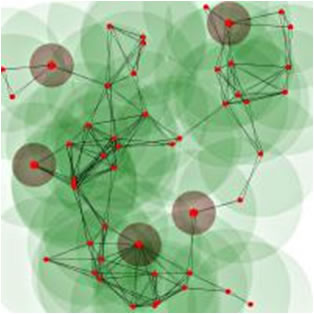
In recent years, sensor networks have emerged as an important class of networks for many military and commercial applications. A sensor network is a collection of wireless communication nodes. Each node is capable of sensing the environment and communicating the measured data to the neighboring nodes, and eventually to the external users. The majority of sensor networks are designed to collect data or to perform anomaly detection. In this research, we study the algorithms and coding techniques for energy efficiency, robustness, accurate localization and collection in sensor networks.
- D. Tran and T. Nguyen, "Hop-Count Based Learning Techniques for Passive Target Tracking in Sensor Networks", submitted to IEEE Transactions on Systems, Man, and Cybernetics, 2007 (Manuscript # SMCA07-06-0164)
- D. Tran and T. Nguyen, "Localization In Wireless Sensor Networks based on Support Vector Machines", IEEE Transactions on Parallel and Distributed Systems (to appear)
- T. Nguyen, D. Nguyen, H. Liu, D. Tran, "Stochastic binary sensor networks for noisy
environments," International Journal of Sensor Networks, Vol 2, No. 6, 2007
- D. Tran and T. Nguyen, "Learning Techniques for Localization in Wireless Sensor Networks", Localization Algorithms and Strategies for Wireless Sensor Networks: Monitoring and Surveillance Techniques for Target Tracking (to be published in 2008, IGI Global)
- T T. Nguyen and D. Nguyen, " Stochastic Binary Sensor Networks for Noisy Environment," IEEE Conference on Communications and Electronics, Oct, 2006
- D. Tran and T. Nguyen, "Support Vector Classification Strategies for Localization in Sensor Networks," IEEE Conference on Communications and Electronics, Oct, 2006
- K. Nguyen, T. Nguyen, C. Chaing, and M. Motani, "A Prioritized MAC Protocol for Multihop, Event-driven Wireless Sensor Networks", IEEE Conference on Communications and Electronics, Oct, 2006.
|